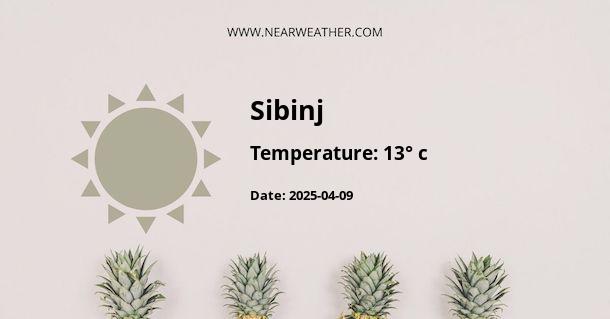Understanding Sibinj’s Microclimate
Located in the picturesque landscape of Croatia, Sibinj is a community that experiences a unique microclimate within the broader context of the Croatian climate, characteristic of the continental and Mediterranean influences that shape the country's weather patterns. Delving into the specifics of Sibinj’s climate requires a thorough understanding of its geographical positioning, prevailing weather systems, and seasonal changes.
Geographical Influence on Sibinj’s Climate
Sibinj's specific location in Croatia plays a pivotal role in the formation of its local weather. Situated inland, away from the Adriatic Sea, Sibinj does not receive the full moderating benefits of the sea. This results in a climate that can be categorized as a humid continental climate, with distinguishable seasons that include hot summers, cold winters, and transitional autumns and springs.
Climate Data: A Detailed Overview
Table 1: Average Temperatures and Precipitation
| Month | Average High (°C) | Average Low (°C) | Precipitation (mm) |
|---|---|---|---|
| January | 3 | -4 | 45 |
| February | 6 | -2 | 40 |
| March | 11 | 1 | 50 |
| April | 16 | 5 | 55 |
| May | 21 | 10 | 65 |
| June | 24 | 13 | 75 |
| July | 27 | 15 | 70 |
| August | 27 | 15 | 65 |
| September | 23 | 11 | 70 |
| October | 17 | 6 | 80 |
| November | 10 | 2 | 85 |
| December | 4 | -3 | 60 |
As this table illustrates, the seasonal climate trends in Sibinj show warmer summers and colder winters, with a relatively even distribution of precipitation throughout the year. Wet periods, which contribute to the region's lush vegetation, often occur in the spring and fall, aligning with the transitional nature of these seasons.
Patterns of Precipitation
While Sibinj does not have a distinctly dry season, rainfall patterns can fluctuate. Rainfall peaks tend to occur in late spring and fall, which is typical of a continental climate. The average annual precipitation is approximately 800 mm, representing a significant amount of rainfall that supports the area’s agriculture and natural ecosystems.
Winter Weather Analysis
The winter months experience the lowest temperatures of the year, often dropping below freezing. Snowfall is common, creating picturesque wintry landscapes but also presenting challenges for transportation and daily activities. Extreme weather conditions, such as ice storms and severe cold spells, are less common but can occur due to the influx of cold air masses from the Eurasian continent.
Summer Heat and Temperatures
In contrast, summers in Sibinj are characterized by warm to hot weather, with temperatures that can occasionally exceed 30°C during heatwaves. The continental influence ensures that summer nights remain relatively cooler, allowing for comfortable sleep. Proximity to bodies of water, such as rivers and lakes, might bring localized climatic variations that typically include higher humidity and potential for fog formation in the mornings.
Autumn and Spring Transitions
The seasons of autumn and spring serve as transitional periods, where temperatures gradually decrease or increase, respectively. These seasons can also be unpredictable, featuring rapid changes in weather conditions, such as sudden temperature drops or warm spells. This variability can have significant implications for agricultural practices and local flora and fauna.
Climate Projections
Global climate change is a pivotal factor in understanding future weather trends for regions like Sibinj. Predictions indicate that Sibinj may experience warmer average temperatures, a shift in precipitation patterns, and an increase in the frequency and intensity of extreme weather events. It is vital for local planners and the community to consider these projections in their long-term sustainability and resilience planning.
Local Weather Anomalies
While the climate data provides a baseline understanding of typical weather patterns in Sibinj, it's important to highlight that weather anomalies can and do occur. Unseasonably warm winters, droughts during usually wet seasons, and unexpected frost events are all examples of such anomalies that can have profound effects on the local ecosystem and human activities.
Expert Insights and Opinions
Climate experts and meteorologists provide valuable insights into the intricacies of Sibinj’s climate, highlighting the impacts of topography, land cover, and larger atmospheric conditions. Their research and expertise are fundamental in creating accurate forecasts and advising on best practices for agriculture, infrastructure development, and emergency preparedness in the face of adverse weather conditions.
Conclusion
Understanding Sibinj’s distinct climate is a complex task that requires an appreciation for the intricate dance between geographical location, global weather patterns, and local topographical features. The region's weather is marked by the four traditional European seasons, but nuanced by the particularities of the Croatian landscape. Ongoing climate research and monitoring are essential for the community of Sibinj to navigate and adapt to the changing climate realities of the 21st century.
A - Sibinj's Latitude is 45.191669 & Longitude is 17.908060.
A - Weather in Sibinj is 13° today.
A - Climate Conditions in Sibinj shows overcast clouds today.
A - Humidity in Sibinj is 52% today.
A - Wind speed in Sibinj is 4.14 km/h, flowing at 342° wind direction. today.
